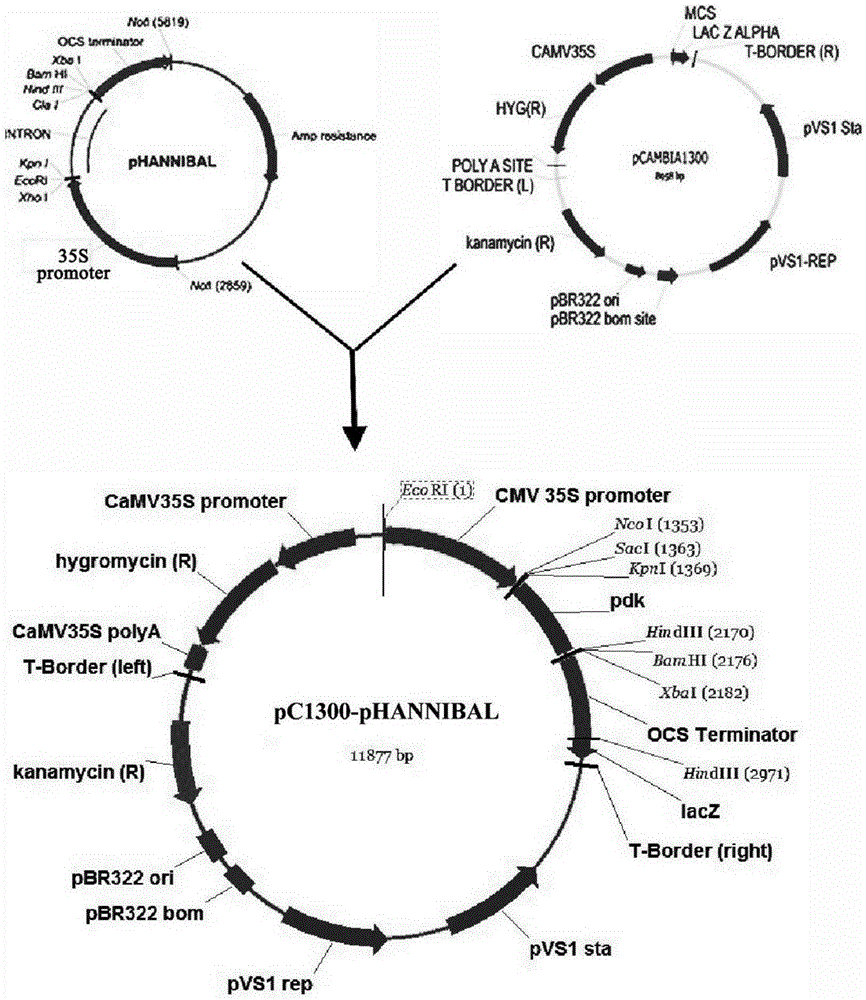RNAi vector widely used for multi-plant gene silencing and application
A gene silencing and vector technology, applied in the biological field, can solve the problems of inability to use plant genetic transformation, and the report of pC1300-pHANNIBAL plant gene silencing vector has not yet been found, and achieve the effect of stable inheritance.
- Summary
- Abstract
- Description
- Claims
- Application Information
AI Technical Summary
Problems solved by technology
Method used
Image
Examples
Embodiment 1
[0041] Example 1: Cloning of CMV promoter and OCS terminator
[0042] 1. pHANNIBAL plasmid extraction
[0043]Pick Trans1-T1 Escherichia coli (purchased from TransGenBiotech) containing the pHANNIBAL carrier, and first dissolve in 750 μl LB medium (weighing 5 g of yeast extract, 10 g of tryptone, and 10 g of NaCl) in 1 L of water, adjust the pH to 7.0, and sterilize at 121 ° C Afterwards, cool to 50°C, add ampicillin antibiotic with a final concentration of 100mg / L) and cultivate overnight; inoculate 20 μl of bacterial solution in 20ml LB medium, and cultivate overnight; use a 1.5ml EP tube to centrifuge at 12000rpm for 1min to collect bacterial cells (per 5ml bacterial solution collected as a tube).
[0044] Add 100 μl solution I (glucose 50mmol / L, Tris-Cl25mmol / L, EDTA10mmol / L, pH=8.0) to the bacteria, resuspend the precipitate; then add 200μl solution II (H 2 (08ml, 10% SDS1ml, 2MNaOH1ml), gently flip the EP tube, 5 to 6 times until the solution becomes clear; add 150 μl ...
Embodiment 2
[0054] Example 2: Construction of pC1300-pHANNIBAL vector
[0055] 1. Construction of 1300-CMV vector
[0056] The two plasmids were double digested with EcoRI and SacI, respectively. The enzyme digestion system is as follows:
[0057]
[0058]
[0059] After preparing the above mixture, gently pipette to mix, incubate in a 37°C incubator for 3.5 hours, then electrophoresis, gel recovery, and connection.
[0060] According to the brightness of the target band after electrophoresis, add the corresponding volume of gel recovery solution according to the molar ratio of the fragment to the carrier of 3:1 to 7:1, and use T4 ligase to connect CMV into the pCAMBIA1300 vector. The connection system is as follows:
[0061]
[0062] After the above mixture is prepared, gently pipette and mix well, and connect overnight at 16°C (about 8-9 hours). The ligation product was transformed into Trans1-T1 Escherichia coli, a single clone was picked, and after correct sequencing, the...
Embodiment 3
[0069] Example 3: Construction and application of TAR1 gene RNAi vector in Artemisia annua
[0070] 1. TAR1-RNAi vector construction
[0071] Obtain the TAR1 sequence (EZ159016) from NCBI, and design a forward primer TAR1-RNAiF with a restriction site near the 3' end: aaa TCTAG AaaaCCATGGcctcttaacaagccagagtc (SEQIDNO: 9) (containing NcoIandXbaI restriction site) and reverse primer TAR1-RNAiR: aaa GGATCC aaa GGTACC ccttggatgagatacactgtc (SEQ ID NO: 10) (containing BamHIandKpnI restriction site), using EasyPfuDNAPolymerase enzyme for PCR amplification. The PCR system and conditions refer to Example 2, and the extension time is 30 sec.
[0072] First use NcoI and KpnI to double digest the TAR1 gene fragment plasmid obtained in the previous step in this example and the pC1300-pHANNIBAL vector plasmid obtained in Example 2, recover from the gel, connect with T4 ligase, and connect the TAR1 gene fragment forward into pC1300 -pHANNIBAL to obtain the 35S:TAR1F::PDK::OCS vector;...
PUM
 Login to View More
Login to View More Abstract
Description
Claims
Application Information
 Login to View More
Login to View More - R&D
- Intellectual Property
- Life Sciences
- Materials
- Tech Scout
- Unparalleled Data Quality
- Higher Quality Content
- 60% Fewer Hallucinations
Browse by: Latest US Patents, China's latest patents, Technical Efficacy Thesaurus, Application Domain, Technology Topic, Popular Technical Reports.
© 2025 PatSnap. All rights reserved.Legal|Privacy policy|Modern Slavery Act Transparency Statement|Sitemap|About US| Contact US: help@patsnap.com



